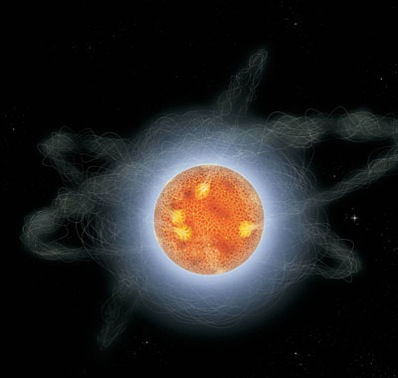X-ray and gamma ray data from ESA's XMM-Newton and Integral orbiting observatories have been used to make the first tests of the physical processes that define magnetars, an unusual class of neutron star with immense magnetic fields.
Neutron stars are the remnants of stars 10-50 times more massive than our Sun that have collapsed in on themselves such that the equivalent mass of our Sun is concentrated into a sphere just 20 kilometres in diameter. Neutron stars are also defined by their extremely fast rotation and ultra-strong magnetic field. Magnetars are a sub-class of neutron star that boast magnetic fields a thousand times stronger than that of ordinary neutron stars, and in total, astronomers know of just 15 such magnetic powerhouses.

X-ray and gamma ray data from ESA’s XMM-Newton and Integral orbiting observatories have been used to test, for the first time, the physical processes thought to lie behind the emission of magnetars, an atypical class of neutron stars with ultra-strong magnetic fields. Image: 2008 Sky & Telescope/Gregg Dinderman.
A magnetar’s magnetic field is so great that it is thought to be capable of twisting its own stellar crust, producing a current in the form of an electron cloud which flows around the star. These currents interact with the radiation coming from the stellar surface, producing X-rays which are observed by satellites such as XMM-Newton and Integral.
Until now, the electron clouds around magnetars were just a theoretical prediction, since it is not possible to produce such ultra-strong magnetic fields in laboratories on Earth. Dr Nanda Rea from the University of Amsterdam and colleagues have now demonstrated the presence of electron clouds around the whole set of known magnetars by building a theoretical code which takes into account the effect of these clouds, and then applying this code to X-ray and low energy gamma ray observations from XMM-Newton and Integral of all 15 magnetars.
“This model could perfectly fit all the data on these objects, resulting in a measurement of the electron density and temperature in the magnetosphere of these big magnets,” Rea tells Astronomy Now. “Their presence demonstrate that indeed the theoretical prediction of a twisted magnetosphere is correct, and that their peculiar X-ray emission (with respect to normal neutron stars) is in great part due to these electron clouds 1000 times denser than in normal neutron stars.”
The results have established an important link between an observed phenomenon and an actual physical process, and the team is now working hard to develop and test more detailed models to fully understand the behaviour of matter under the influence of such strong magnetic fieldsfrom:http://astronomynow.com/081117XMMandIntegralunveilmagnetarenvironment.html





 RSS Feed (xml)
RSS Feed (xml)